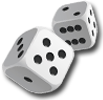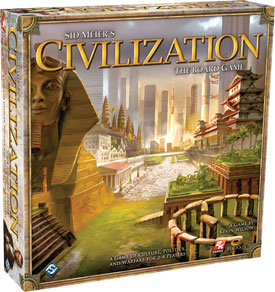



play board games
Board game reviews, strategy tips & session reports
Civilization: the Board Game Review
 Stats:
Stats:
No. of players: 2-4
Amount of time to play: 180 min
Age requirements: 13+
Set-up time: 15 min
Civilization the Board Game Rules Description:
Civilization: the Board Game is an adaptation of Sid Meier’s popular computer game Civilization. Your goal is to become the most powerful civilization on the map. This goal can be met in four different ways. The avenues for winning include military, culture, economic and technology.
The map for the game is made up of randomly chosen tiles. With the tiles in the center placed face-down. This adds variety to the game and some uncertainty of what you’ll find when you discover certain sections of the board.
At the beginning of the game you get your civilization you choose to play. Certain civilizations are better at one (or possibly 2) of the strategies to winning. Each civilization gets a different starting technology and capital city as well as scouts and armies.
You choose a starting player and take the following five phases each Game Turn.
1. Start of Turn
2. Trade
3. City Management
4. Movement
5. Research
During the Start of Turn phase you may switch governments (if you have researched new ones), build a new city, or perform start of turn actions from their culture cards (see below). After the first player finishes this phase each player in turn performs the phase.
The Trade phase happens simultaneously as all players total their trade from all their cities. You may also trade Trade for resources or future promises. Everyone adjusts their trade dials and play returns to the first player for the next phase.
City Management is taken in player order. You may take one of three actions in the City Management phase. Either Produce a figure, unit, building or wonder, Devote your city to the Arts, or Harvest a Resource. To produce something in your city you add up the hammer icons. The total number of hammer icon you have in that city must be greater than or equal to the cost of the item you wish to build. You may exchange Trade into Production at a rate of three to one.
The item you build is added to the city outskirts of your city (one of the eight squares adjacent to it) . Certain buildings may only be built on certain terrain and other buildings are unique and you may only build one unique building per city. I am not going to detail all the buildings here, but certain buildings or wonders will help you pursue one of the four main strategies to winning the game.
Devoting a city to the Arts moves gets you Culture tokens. You receive one token plus one for every culture icon you have in your city. You spend your Culture tokens during your City management phase to move your civilization up the Culture track. Certain spaces on the Culture track will produce a great person or give you culture event cards.
Great people are settled in your city outskirts and will give you benefits toward one of the strategies of winning. They are selected at random though. Cultural event cards can get you resources, cause revolts in other player’s cities or even kill a great person.
Harvesting a resource is what it is. You may harvest any resource from the city outskirts or your city. Resources are used to power some abilities on tech cards.
City Management is done once for each city you have and then play proceeds to the player on your left. Once all players have finished their City Management, the starting player begins the Movement phase.
The Movement phase is pretty much exactly what it sounds like. You may move your figures up to your travel speed around the board. You may not move diagonally and once a figure has started its movement it cannot stop wait for another figure and then move again. If you move next to an undiscovered tile you may spend one square of movement to flip it over.
Once you discover a tile you place any huts or villages and may move on it. Huts and villages represent the natives and may be explored by your army figures. Huts peacefully join your civilization while villages are filled with barbarians and fight the invading army. The barbarian village is played by the person in your left and I’ll detail the combat rules shortly.
Last is the Research phase. Each player simultaneously chooses a technology to research. Researching costs Trade and the cost depends on the level of technology you are researching. When adding a new technology to your technology tree it must have two lower level techs under it. So your technology tree will resemble a pyramid with lower level techs supporting higher ones.
Technologies can increase your travel speed, allow you to change governments, upgrade your army units and again help you in your overall strategy. When you spend trade on research you must spend all your trade no matter the cost of the technology you are researching.
The starting player token is passed to the left and the Game turn starts anew.
Combat occurs during movement and involves your artillery, mounted and infantry units. There is a rock-paper-scissors interaction between the units. Attacks are made along a front and the defender lays a unit first. The attacker then chooses to either lay a unit across from the defender’s unit or start a new front. If two units are on the same front they immediately attack each other. Units have a damage value that increases as you upgrade them. Units damage each other at the same time unless one of the units trumps the other one. If so the trumping unit does its damage first. Artillery units trump infantry which trump mounted which trump artillery. After both players have laid their entire hand of units the total strength of the remaining units are compared. Whichever side has the highest value wins the combat. Ties go to the defender.
Winners of combat get to take trade points, culture tokens or one resource from the loser. If the loser is defending one of their non-capital cities you may steal one of their technologies, culture event cards, or any two resources. Defeating another player’s capital city grants you a military victory.
Another aspect of the game is economic power. This power is represented by coins. You get coins from great people, buildings, map tiles or by performing tasks to get them on certain tech cards. Coins help you when you research a new technology by allowing you to keep as much trade as you have coins. Also if you get enough coins you can win the game.
At the beginning of this I mentioned there were four roads to winning the game. As stated above capturing another player’s capital city gives you a military victory. To win a cultural victory you must get to the end of the culture track which is 21 spaces long. You will need to research the space program for a technology victory. This is a level five technology so it will take at least 15 techs to accomplish it. An economic victory requires you to have 15 coins.
A Quick Review of Civilization the Board Game:
Civilization the Board Game is fun. It is gorgeous. And although it seems very complicated after a few turns you should have a decent handle on the Game Turn and your options in each phase. There is a good bit of strategy. And even though the civilization you choose guides you, there are a variety of ways to win. If you are a fan of the computer series you will appreciate the ways the board game interprets and mirrors it.
The problems with the game are overall time and down-time as well as some of the cultural event cards being really tough to overcome. There are also a lot of rules to keep track of and you’ll find yourself missing some the first few times you play.
The downtime can be really bad if you are playing with someone with analysis paralysis and the game length is just too long.
This is another game I rented from BoardGameExchange and I am glad I did. Don’t get me wrong I really did enjoy playing the board game. But the length of time and learning curve means it would rarely hit my game table. If I wanted to devote around 3-4 hours to a board game I am not sure Civilization is what I’d reach for either.
All that said I think it is worth trying if you get the chance. If you are a fan of the series and have a dedicated game group that would enjoy this, I say go for it.
Score and synopsis: (Click here for an explanation of these review categories.)
Strategy 4 out of 6
Luck 3 out of 6
Player Interaction 5 out of 6
Replay Value 4 out of 6
Complexity 5 out of 6
Fun 4 out of 6
Overall 4 out of 6

Civilization without the AI bugs and crashes to desktop? Sign me up!